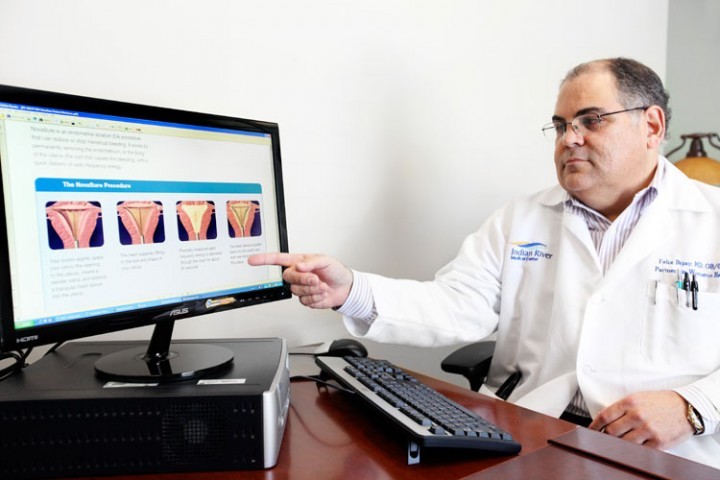
INDIAN RIVER COUNTY — Partners in Women’s Health, a practice that delivers 80 percent of all the babies in Indian River County, moved into a new facility last month and is looking to provide more access to women in need of both obstetrical and gynecological services by hiring new doctors.
Some of those services – likely starting this fall after two new physicians join the staff – include appointments at night and on weekends and more in-office medical procedures, says Donna Riordan, Indian River Medical Center’s director of women’s health.
“We’re going to be looking at times,” says Riordan. “Some working women couldn’t come in during the day. We have two new physicians coming in September and we’re looking at nights and possibly one weekend a month. We feel this is something in our community that is needed. People work.”
One example of what the group, now located at 1050 37th Place across from the medical center, began doing after it moved into its new facility last month is an in-office procedure to reduce or stop heavy menstrual bleeding, a problem that affects about one in five women.
Prior to the group’s move, that procedure – which removes the lining of the uterus – was done in the hospital and required a lot more preparation and paperwork because of the medical center setting.
“Sometimes it may take the whole morning or whole afternoon,” says Dr. Felix Bigay, the Partners in Women’s Health medical director.
In the office setting, the ablation procedure, where the lining of the uterus is removed, takes about 90 seconds and patients are in the office for about 90 minutes.
The NovaSure machine used in the procedure is the size of a typewriter. It uses a wand-like device to insert a triangular mesh into the uterus.
Bigay said the device then expands the mesh to the size and shape of a woman’s uterus. A radio frequency then is directed through the mesh from about 90 seconds.
Bigay then pulls the mesh back into the wand and removes it from the uterus. The mesh takes the uterus lining with it.
“Here in the office, I’ve done two (in the last month),” says Bigay. “I’m surprised myself at how well the patients have done. The first patient was apprehensive about the procedure but was talking to me (during it) like nothing was happening. One of the patients was reading a book.”
Bigay, who did his internship and residency at New York City’s Catholic Medical Center, says he would not have attempted the same procedure when he started practicing medical 18 years ago.
“I didn’t even attempt to do these procedures because they were time-challenging and so difficult that only a few physicians were qualified to do them.”
Improvements in technology make it much simpler.
“This is a big, big improvement in technology,” says Bigay.
Female health procedures have improved in much the same way as gall bladder or appendix surgery, Bigay notes, by offering much less invasive processes that come with a much faster recovery period.
“There have been big changes with improved technology and with more changes to come,” he says.
Riordan notes there is a significant difference in both cost and time between the in-office procedure and the in-hospital procedure.
For example, she estimates the cost of the office procedure is about $2,400 versus $8,000 if conducted in the hospital setting.
“It’s about a fourth of the cost,” she says.
“Recovery time is minimal,” says Riordan. “It is very satisfying all the way around.”
That means the patients can undergo the procedure, go home, rest overnight and return to work the next day.
Another significant difference in doing the procedure in an office setting, says Bigay, is big savings in some patient co-pays. At the hospital, the co-pay could run $1,000 while in the Partners in Women’s Health office the co-pay could be $20.
Not every woman is a candidate for the procedure, Bigay says, noting it is not for women who might have uterine cancer or who still want to get pregnant.
Partners in Women’s Health – started in 1995 – was developed, says Riordan, with the goal in mind of reducing infant mortality rates.
With funding though the Health Taxing District, Riordan says the practice sees not only indigent patients – who often have riskier pregnancies – but patients who “could buy this building.”
“We want to be the portal into health care for women,” says Riordan, adding that continuity of care is very important to pregnant women and that a staffer monitors their appointments, tracking them down for an explanation when one is missed.
“It’s made a huge difference,” Riordan said.
Getting women in to see a doctor also is something the practice takes seriously.
“We see a lot of high-risk patients,” says Riordan.
She says many are obese which often comes with side problems such as high blood pressure and diabetes.
“When we are fully staffed, we’ll be able to see them every week,” Bigay says.
In addition to appointments, the practice also offers a class for women with high-risk pregnancies.
Riordan says 875 patients attended the high-risk class in 2010.
Working with high-risk patients in that fashion, she says, can cut down on problems later in the pregnancy or those involved with premature births, a very expensive medical situation.



